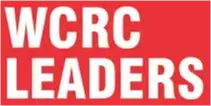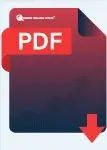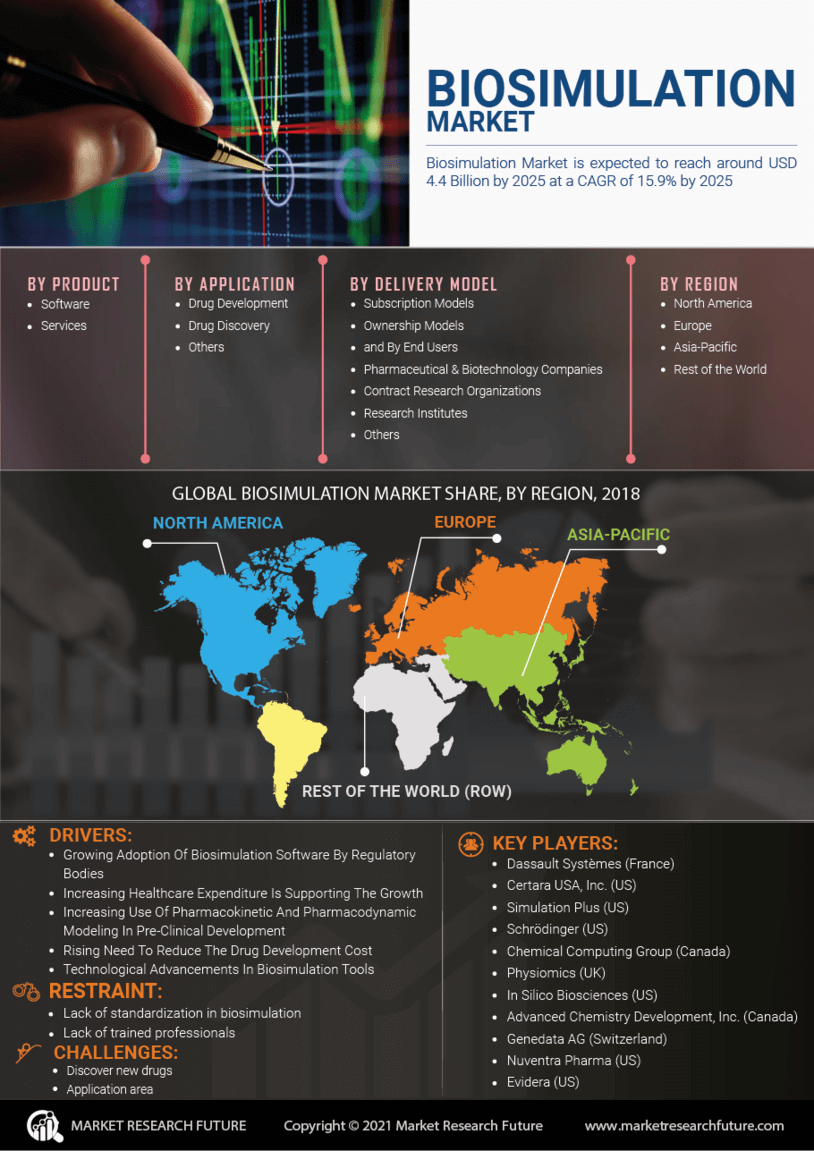Bio-simulation Market Overview:
As per MRFR analysis, the Bio-simulation Market Size was estimated at 1.98 (USD Billion) in 2022. The Bio-simulation Market Industry is expected to grow from 2.17(USD Billion) in 2023 to 5.0 (USD Billion) by 2032. The Bio-simulation Market CAGR (growth rate) is expected to be around 9.7% during the forecast period (2024 - 2032).
Key Bio-simulation Market Trends Highlighted
The Bio-simulation Market is expected to grow due to the advancements in technology. As the pharmaceutical industry is under constant pressure to minimize time to research and develop new drugs, biosimulation tools that enable predictive modeling and simulations have become critical to this shift. In addition, the increase in artificial intelligence and machine learning has aided the development of biosimulation approaches by improving the accuracy and efficiency of simulations. The growing need for customized therapy also drives the growth as biosimulation assists in formulating treatment for the specific patient. There are enormous opportunities to be realized notwithstanding this market.
Biopharmaceutical companies are increasingly recognizing the value of biosimulation for optimizing compound selection and reducing the need for extensive animal testing. Collaboration between academia and industry can lead to innovative biosimulation approaches, fostering an environment ripe for new applications. In addition, the expansion of regulatory guidelines supporting the integration of biosimulation in drug development presents significant avenues for investment and growth within the sector. Improved accessibility of biosimulation tools for small and medium enterprises is also anticipated to stimulate adoption. In recent times, there has been a notable trend toward integrating biosimulation into early-phase clinical trials.
This approach enhances the understanding of pharmacokinetics and pharmacodynamics in the initial stages of drug development. Moreover, there is a growing emphasis on leveraging biosimulation data for regulatory submissions as agencies become more receptive to these models in decision-making processes. The rise of wearable technology and real-world data collection is further enriching the biosimulation landscape, allowing for more accurate predictive models. The ongoing evolution and integration of these technologies make the Bio-simulation Market a dynamic and promising field.
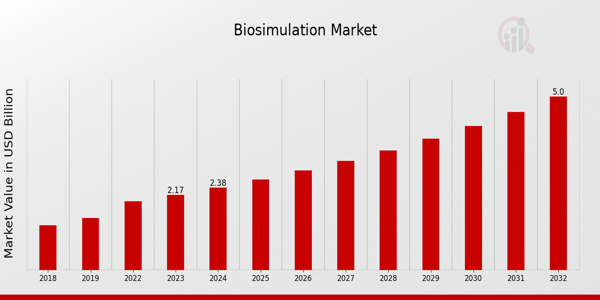
Source: Primary Research, Secondary Research, MRFR Database and Analyst Review
Bio-simulation Market Drivers
Increasing Demand for Drug Development Efficiency
The Bio-simulation Market Industry is experiencing rapid growth fueled by the increasing demand for more efficient drug development processes. With the high costs and lengthy durations associated with traditional drug development, pharmaceutical companies and research institutions are increasingly turning to biosimulation technologies. These technologies enable the in-silico modeling of biological systems, allowing researchers to predict drug behavior, optimize dosage, and reduce the need for extensive clinical trials.
By leveraging biosimulation, organizations can significantly shorten the drug development timeline, resulting in substantial cost savings while ensuring that new therapies are brought to market more quickly and safely. The ability to simulate various biological scenarios allows industry players to enhance their understanding of drug interactions and therapeutic efficacy, thereby improving the overall success rate of new medications. As the pharmaceutical sector continues to face pressure to deliver innovative solutions at a lower cost and faster pace, the role of the Bio-simulation Market Industry becomes increasingly critical.
This push for efficiency not only boosts the demand for biosimulation solutions but also fosters greater collaboration between academia and industry as they seek to validate and refine these predictive models. Consequently, the integration of biosimulation technologies is expected to be a key driver of growth in the Bio-simulation Market.
Rising Focus on Personalized Medicine
The rising focus on personalized medicine is significantly driving the Bio-simulation Market Industry. As healthcare increasingly shifts toward tailored treatment approaches, biosimulation plays an essential role in understanding individual patient responses to therapies. By modeling patient-specific biological systems, researchers can predict how different genetic profiles and health conditions would influence drug efficacy and safety, thus paving the way for customized treatment solutions.
This trend directly aligns with the industry's goal of improving patient outcomes while minimizing adverse effects, making biosimulation an invaluable tool for research and development.
Advancements in Computational Technologies
Advancements in computational technologies are acting as a significant catalyst for growth within the Bio-simulation Market Industry. Innovations in computer hardware and software have enabled more complex simulations to be performed with greater accuracy and speed. As modeling techniques become increasingly sophisticated, researchers can analyze larger datasets and simulate intricate biological processes, thereby enhancing their understanding of drug interactions and metabolic pathways.
This technological evolution enhances the capabilities of biosimulation tools, empowering pharmaceutical researchers to make more informed decisions throughout the drug development process.
Bio-simulation Market Segment Insights:
Bio-simulation Market Application Insights
The Bio-simulation Market is experiencing significant growth in its Application segment, which includes areas such as Drug Discovery, Toxicology Testing, Clinical Trials, and Predictive Modelling. In 2023, the Application segment was poised to play a vital role in the market, which is valued at 2.17 USD Billion overall. Drug Discovery stands out with a value of 1.1 USD Billion, signifying a majority holding within the segment, driven by the increasing demand for advanced methodologies in drug research and development. This area is crucial as it reduces the time and costs associated with bringing new drugs to market, thereby accelerating innovation.
Toxicology Testing commands a notable presence as well, valued at 0.65 USD Billion in 2023, highlighting its importance in assessing the safety and efficacy of compounds prior to clinical use. As regulatory requirements heighten, this segment is expected to witness further growth, underlining its significance in the overall health and pharmaceutical sectors. Clinical Trials are valued at 0.25 USD Billion in 2023, reflecting their essential role in verifying the safety and effectiveness of treatments before they reach patients. This segment is critical for ensuring compliance with regulatory standards and securing approvals for market entry.
Lastly, Predictive Modelling, while the least valued at 0.17 USD Billion in 2023, is gaining traction as it provides insights into potential outcomes and optimizes processes within drug development. The integration of predictive analytics into the biosimulation process enhances decision-making, helping organizations mitigate risks and improve efficiency. Collectively, these segments contribute to the overall expansion of the Bio-simulation Market, with opportunities driven by technological advancements, rising R investments, and the growing focus on personalized medicine shaping the future landscape of this industry.
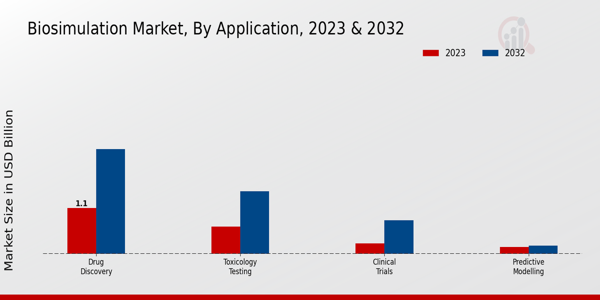
Source: Primary Research, Secondary Research, MRFR Database and Analyst Review
Bio-simulation Market Technology Insights
The Bio-simulation Market, particularly in the Technology segment, is experiencing notable growth, with an expected valuation of 2.17 billion USD in 2023. This market is characterized by its diverse methodologies, including Physiologically Based Pharmacokinetic Modelling, Quantitative Structure-Activity Relationship, and Cellular and Molecular Modelling. Physiologically Based Pharmacokinetic Modelling is essential for predicting drug absorption and distribution in the human body, making it a critical tool in pharmacology. Quantitative Structure-Activity Relationship plays a vital role in assessing the relationships between chemical structure and biological activity, influencing drug discovery significantly.
Cellular and Molecular Modelling serves as a cornerstone for understanding biological processes at a cellular level, which is crucial for targeted therapies. Collectively, these technologies are pivotal to enhancing drug development efficiency and safety, responding to the growing demand for advanced simulation technologies in the pharmaceutical sector. The Bio-simulation Market revenue is expected to rise further, reflecting a strong market growth trajectory driven by increasing investments in R and the demand for personalized medicine.
Market data indicates that the expansion of biopharmaceuticals and a growing emphasis on innovative therapies are key factors propelling this segment forward, shaping the landscape of the Bio-simulation Market industry.
Bio-simulation Market End User Insights
The Bio-simulation Market, valued at 2.17 billion USD in 2023, showcases significant interest across various end-user sectors, primarily including Pharmaceutical Companies, Biotechnology Firms, Research Institutions, and Contract Research Organizations. Pharmaceutical Companies are increasingly leveraging biosimulation technologies to streamline drug development processes, enhance predictive accuracy, and reduce costs, which drives substantial market growth. Biotechnology Firms utilize these tools for novel therapeutic solutions and optimizing bioprocesses, thereby demonstrating a significant portion of the market.
Research Institutions contribute to advancements in biosimulation approaches, fostering innovation and knowledge creation in life sciences. Contract Research Organizations play a critical role in offering specialized services, allowing smaller entities access to sophisticated simulations without the need for in-house capabilities. The overall market growth is underpinned by the rising complexity of drug development, growing regulatory demands, and the increasing adoption of in-silico models. As the market evolves, embracing cutting-edge biosimulation technologies offers opportunities to enhance efficiency and effectiveness in biopharmaceutical research.
Bio-simulation Market Type Insights
The Bio-simulation Market in 2023 was valued at 2.17 USD billion, reflecting a robust interest in innovative solutions within the pharmaceutical and biopharmaceutical sectors. This market is characterized by two primary categories: Software and Services, both of which play critical roles in enhancing productivity and streamlining drug development processes. Software solutions are predominant in the market, enabling professionals to conduct complex simulations that uncover significant biological interactions and outcomes. On the other hand, Services, which include consulting and support offerings, are essential for optimizing the use of biosimulation tools, ensuring clients achieve their desired outcomes effectively.
The increasing emphasis on cost-effective research methodologies and regulatory compliance further drives the utilization of these segments. The growth of the Bio-simulation Market can be attributed to the rising demand for personalized medicine and the need for faster clinical trial methodologies. Furthermore, advancements in technology and a growing focus on mitigating drug development risks are key growth drivers fueling the anticipated expansion of the market.
Bio-simulation Market Regional Insights
The Bio-simulation Market, valued at 2.17 USD Billion in 2023, displays significant regional differentiation in its performance and growth potential. North America leads the market with a valuation of 0.9 USD Billion in 2023, increasing to 2.1 USD Billion by 2032, demonstrating a majority holding that emphasizes its pivotal role in the industry, driven by advanced technologies and substantial R investments. Europe follows, valued at 0.6 USD Billion in 2023 and forecasted to reach 1.3 USD Billion, fueled by a robust regulatory framework and a growing focus on personalized medicine.
APAC shows promising growth, with a market size of 0.4 USD Billion in 2023, expected to double by 2032, as increasing healthcare expenditure and rising awareness drive market expansion. South America, while smaller, with a valuation of 0.15 USD Billion, is expected to reach 0.3 USD Billion, reflecting growing healthcare initiatives. Meanwhile, the MEA region, valued at 0.12 USD Billion in 2023 and projected to grow to 0.5 USD Billion, is gaining traction due to emerging biotechnology sectors and investments in health infrastructure. These insights showcase distinct regional dynamics and varying market growth factors essential for understanding the Bio-simulation Market segmentation.
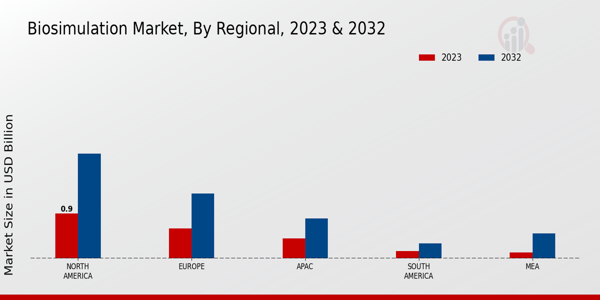
Source: Primary Research, Secondary Research, MRFR Database and Analyst Review
Bio-simulation Market Key Players and Competitive Insights:
The Bio-simulation Market is characterized by rapid advancements and a heightened focus on virtual modeling techniques that aid in drug development and biological research. This market is becoming increasingly competitive as organizations strive to innovate their offerings, enhance product development timelines, and lower costs associated with pharmaceutical research. Various players in this market are focusing on different biosimulation technologies, such as computational modeling, in silico testing, and systems biology, to provide solutions that meet the evolving needs of researchers and pharmaceutical industries. The growing demand for personalized medicine and increasing regulatory pressures are driving investment in biosimulation technologies, leading to an intensified competitive landscape where companies aim to differentiate their services and capture significant market share.
Schrodinger has established itself as a prominent player in the Bio-simulation Market, recognized for its advanced computational chemistry software and simulation tools. The company's specialized focus on drug discovery and development utilizing biosimulation has allowed it to develop robust platforms that streamline the drug design process. With its strong commitment to research and development, Schrodinger continuously enhances its offerings, providing users with sophisticated tools that facilitate predictive modeling and offer insights into molecular interactions. The integration of artificial intelligence with biosimulation technologies has further strengthened Schrodinger's capabilities, enabling the rapid analysis of complex biological systems. By leveraging its cutting-edge computational frameworks, Schrodinger is able to deliver valuable solutions to biopharmaceutical companies seeking to optimize their research and development workflows.
Insilico Medicine is another influential entity within the Bio-simulation Market, focusing on harnessing the power of artificial intelligence to augment drug discovery processes. The company stands out for its innovative approach to biosimulation, employing machine learning and deep learning methodologies to generate predictive models capable of identifying potential therapeutic candidates. Insilico Medicine combines genomic data and biomarker identification with biosimulation techniques, which empowers researchers to make informed decisions during the drug development process. The unique application of AI in its biosimulation initiatives positions Insilico Medicine as a leader in the market as it enables faster and more accurate predictions of drug interactions and patient responses. This approach not only elevates the drug discovery timeline but also enhances the precision of targeting therapeutics, thus solidifying Insilico Medicine's reputation in an increasingly competitive environment.
Key Companies in the Bio-simulation Market Include:
- Schrodinger
- Insilico Medicine
- Selventa
- PhysioLogic
- Simulations Plus
- Synlogic
- Emulate
- Celerion
- InSilico Technologies
- CellCT
- Adaptive Biotechnologies
- Biomodels
- Mimetic Bio
- Certara
- Ariadne Genomics
Bio-simulation Market Industry Developments
Recent developments in the Bio-simulation Market have showcased a dynamic landscape marked by innovation and strategic moves among key players. Companies such as Schrodinger and Insilico Medicine have been making strides in drug discovery and development through advanced biosimulation technologies that enhance predictive capabilities. Selventa and PhysioLogic are also contributing to the sector by focusing on personalized medicine and improved simulation models. Notably, Simulations Plus has expanded its software offerings aimed at optimizing pharmacokinetic studies, further boosting its valuation and market presence.
Additionally, Synlogic has been at the forefront of utilizing biosimulation for engineering beneficial microbes. In terms of mergers and acquisitions, significant movements have been noted, with companies like Certara and Ariadne Genomics solidifying their positions through collaborative efforts aimed at enhancing biosimulation methodologies. The increasing adoption of biosimulation technologies is driving significant growth in market valuation, demonstrating an adaptation to more efficient research and development processes in the pharmaceutical sector. This adaptation reflects on broader trends toward cost reduction and time savings in drug development, further solidifying the relevance of biosimulation in advancing healthcare solutions.
Bio-simulation Market Segmentation Insights
Bio-simulation Market Application Outlook
- Drug Discovery
- Toxicology Testing
- Clinical Trials
- Predictive Modelling
Bio-simulation Market Technology Outlook
- Physiologically Based Pharmacokinetic Modelling
- Quantitative Structure-Activity Relationship
- Cellular and Molecular Modelling
Bio-simulation Market End User Outlook
- Pharmaceutical Companies
- Biotechnology Firms
- Research Institutions
- Contract Research Organizations
Bio-simulation Market Type Outlook
Bio-simulation Market Regional Outlook
- North America
- Europe
- South America
- Asia-Pacific
- Middle East and Africa
|
Report Attribute/Metric
|
Details
|
|
Market Size 2022
|
1.98(USD Billion)
|
|
Market Size 2023
|
2.17(USD Billion)
|
|
Market Size 2032
|
5.0(USD Billion)
|
|
Compound Annual Growth Rate (CAGR)
|
9.7% (2024 - 2032)
|
|
Report Coverage
|
Revenue Forecast, Competitive Landscape, Growth Factors, and Trends
|
|
Base Year
|
2023
|
|
Market Forecast Period
|
2024 - 2032
|
|
Historical Data
|
2019 - 2022
|
|
Market Forecast Units
|
USD Billion
|
|
Key Companies Profiled
|
Schrodinger, Insilico Medicine, Selventa, PhysioLogic, Simulations Plus, Synlogic, Emulate, Celerion, InSilico Technologies, CellCT, Adaptive Biotechnologies, Biomodels, Mimetic Bio, Certara, Ariadne Genomics
|
|
Segments Covered
|
Application, Technology, End User, Type, Regional
|
|
Key Market Opportunities
|
Increasing demand for drug discovery, Advancements in computational biology, Rising focus on personalized medicine, Growth in regulatory support, Enhancements in cloud-based solutions
|
|
Key Market Dynamics
|
Technological advancements in modeling, Growing demand for personalized medicine, Regulatory support and compliance, Rising R expenditures in biopharma, Increasing focus on cost-effective drug development
|
|
Countries Covered
|
North America, Europe, APAC, South America, MEA
|
Biosimulation Market Highlights:
Frequently Asked Questions (FAQ) :
The Bio-simulation Market is projected to be valued at 5.0 USD Billion by the year 2032.
The expected CAGR for the Bio-simulation Market from 2024 to 2032 is 9.7%.
Drug Discovery is anticipated to have the highest market value at 2.5 USD Billion in 2032.
The Toxicology Testing segment is expected to reach a market value of 1.5 USD Billion by 2032.
North America is expected to dominate the Bio-simulation Market with a value of 2.1 USD Billion by 2032.
The Clinical Trials application is projected to reach a market size of 0.8 USD Billion by 2032.
Major players in the Bio-simulation Market include Schrodinger, Insilico Medicine, and Simulations Plus, among others.
The Predictive Modelling application is expected to have a market value of 0.2 USD Billion by 2032.
The APAC region is anticipated to reach a market value of 0.8 USD Billion by 2032.
The South American market is expected to be valued at 0.3 USD Billion by 2032.

